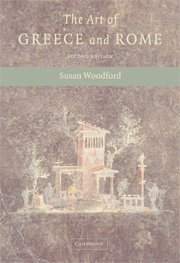Book contents
- Frontmatter
- Contents
- List of Illustrations
- Acknowledgements
- Maps
- Introduction
- PART I THE ARCHAIC AND CLASSICAL PERIODS: PROGRESS AND PROBLEMS
- PART II THE FOURTH CENTURY BC AND THE HELLENISTIC PERIOD: INNOVATION AND RENOVATION
- 4 Sculpture
- 5 Painting
- 6 Architecture and Planning
- PART III THE ROMAN WORLD: ADOPTION AND TRANSFORMATION OF THE GREEK LEGACY
- Epilogue
- Appendix: How We Know What We Think We Know
- Glossary
- Further reading
- Index
5 - Painting
- Frontmatter
- Contents
- List of Illustrations
- Acknowledgements
- Maps
- Introduction
- PART I THE ARCHAIC AND CLASSICAL PERIODS: PROGRESS AND PROBLEMS
- PART II THE FOURTH CENTURY BC AND THE HELLENISTIC PERIOD: INNOVATION AND RENOVATION
- 4 Sculpture
- 5 Painting
- 6 Architecture and Planning
- PART III THE ROMAN WORLD: ADOPTION AND TRANSFORMATION OF THE GREEK LEGACY
- Epilogue
- Appendix: How We Know What We Think We Know
- Glossary
- Further reading
- Index
Summary
SOURCES OF INFORMATION AND THEIR VALUE
Although we know that many masterpieces were painted in the 4th century bc and the Hellenistic period, hardly anything has survived. In order to get some idea of what painting was like at that time, we have to rely on three sources of information: pictures on pottery, copies of paintings made for the Romans and descriptions by ancient authors. None of these is entirely satisfactory.
Vase painters never copied wall paintings exactly, but they sometimes made use of new ideas about the treatment of space, perspective and the handling of light that are so alien to the technique of vase painting that we can deduce that they must have been inspired by developments in free painting. After the 5th century bc, vase painting became a minor art and could only dimly reflect the great achievements taking place elsewhere. By the end of the 4th century bc, it had virtually died out.
Copies of Greek paintings made for the Romans, though closer to the sources of their inspiration than paintings on pottery, are not as accurate as the more mechanically produced Roman copies of statues. Sometimes, when we can compare several copies of the same original, it becomes obvious that the Roman painters freely adapted and modified their models (Figs. 104 and 105, p. 101).
Descriptions by ancient writers, though often vivid and entertaining, can never bring lost works before our eyes.
- Type
- Chapter
- Information
- The Art of Greece and Rome , pp. 72 - 80Publisher: Cambridge University PressPrint publication year: 2004



